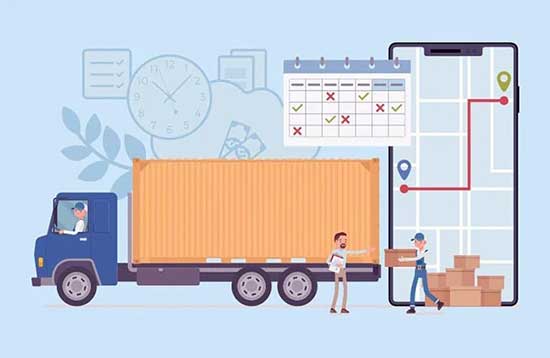

In the previous blog, we covered the pain points faced by eCommerce businesses and 3PLs in achieving peak performance during the holiday season, along with strategies to optimize inventory and warehouse management. In this blog, we will explore effective strategies to enhance the transportation of goods and services during peak periods, focusing on key details.
Shipping and Delivery Strategies
Keeping a customer waiting is NOT acceptable for any business. Therefore, it's imperative that 3PL providers put effective shipping and delivery strategies in place using robust Transportation Management Systems (TMS) to ensure customer satisfaction.
Offering multiple delivery options
Providing multiple shipping options gives customers the flexibility to choose their preferred delivery slots. Here are some of the common delivery options that businesses can offer:
- Same-Day / Express Delivery: It provides customers with the fastest possible delivery, often on the same day or within a few hours. It's valuable for high-demand products or urgent orders.
- Next-Day Delivery: This option ensures delivery to customers within the next business day, offering a faster turnaround than standard shipping.
- Standard Shipping: This is the most common delivery option, and typically takes a few days to deliver. It's suitable for less urgent orders and can be more cost-effective than faster options.
By offering multiple delivery options, businesses can cater to a wider range of customer preferences and needs. This can lead to increased sales, improved customer satisfaction, and a stronger competitive advantage. Additionally, offering quicker delivery options can be particularly beneficial during peak seasons or for premium products.
Partnering with Multiple Carriers: Diversifying and Avoiding Delays
Partnering with multiple carriers can help businesses mitigate delivery delays and ensure reliable shipping services. By diversifying their carrier network based on inputs derived from TMS software, companies can reduce their reliance on any single carrier and improve their ability to handle unexpected disruptions.
Here are some of the key benefits of partnering with multiple carriers:
- Reduced Risk of Delays: If one carrier experiences any disruptions or service failures, businesses can rely on alternative options to ensure timely deliveries.
- Improved Negotiation Power: Having multiple carrier relationships can give businesses more bargaining power when negotiating rates and services. This can help save money and improve terms of delivery.
- Access to a Wider Range of Services: Different carriers have varying strengths in different regions or countries. By partnering with multiple carriers, businesses can ensure their products reach customers worldwide, regardless of location.
- Enhanced Flexibility: By partnering with multiple carriers, businesses can adapt to changing shipping needs and requirements. They can also get access to different delivery options and services, such as expedited shipping, international delivery, or specialized handling.
While selecting carriers, businesses should consider factors such as timely delivery, reliability, coverage, pricing, and the types of services offered. By carefully evaluating these factors and diversifying their carrier network, businesses can improve their shipping efficiency, reduce the risk of delivery delays, and meet the diverse needs of their customers.
Route Optimization Tools for Faster and More Efficient Deliveries
Route optimization tools, which are part of TMS software, enable businesses to deliver products efficiently and cost-effectively. These tools use advanced algorithms to plan the most efficient routes for delivery vehicles, considering factors such as distance, traffic, delivery windows, vehicle capacity, and driver locations.
By using route optimization tools, businesses can:
- Reduce Fuel Costs: Minimize the distance traveled by delivery vehicles, leading to lower fuel consumption and reduced costs.
- Reduce Carbon Footprint: Optimize route planning to reduce empty runs. The additional fuel consumption associated with empty runs leads to increased carbon emissions.
- Improve Delivery Times: Optimize routes with data obtained from logistics software to ensure that deliveries are made on time or even ahead of schedule.
- Increase Driver Efficiency: Provide drivers with clear and efficient routes using GPS-integrated TMS software, reducing the time they spend on the road and increasing productivity.
- Enhance Customer Satisfaction: Deliver products on time and reduce delivery delays, improving customer satisfaction and loyalty.
Proactive communication with customers
Effective communication with customers helps maintain trust and satisfaction, especially while dealing with shipping delays or unexpected disruptions. Transportation management systems enable businesses to maintain such communication seamlessly. Proactive communication involves informing customers about potential delays in advance, providing updates on the situation, and offering solutions or alternatives.
Here are some key strategies for proactive communication:
- Real-time Updates: Provide customers with real-time updates on their order status, including any anticipated delays, through email, SMS, or in-app notifications.
- Transparent Communication: Be honest and transparent about any shipping challenges or delays. Avoid making false promises.
- Offer Alternatives: If a delay is unavoidable, offer customers alternative options, such as expedited shipping or a store credit.
- Provide Compensation: For significant delays or inconveniences, consider offering compensation, such as a discount or a gift.
- Empathize and Apologize: Show empathy for any inconvenience caused by the delay and apologize sincerely.
By proactively communicating with customers about shipping delays, businesses can demonstrate their commitment to customer satisfaction and build trust. This can help mitigate negative impacts on customer experience and maintain a positive brand reputation.
Returns Management
Returns are a hassle, but they are inevitable. TMS software that enables a smooth and efficient return process is crucial for 3PL providers, especially during the holiday season when there is a spike in demand. This ensures timely and hassle-free returns for customers, reduces labor and transportation expenses, minimizes inventory losses, and avoids overstocking. By streamlining procedures and utilizing advanced technologies like AI and Predictive analytics, 3PL providers can lessen the impact of returns on profits, maintain a positive customer experience for quick and easy returns, and support the supply chain.
An important step towards positive customer experience is streamlining reverse logistics. This includes automating returns processing using TMS software and tracking returns, generating return labels, and managing refunds. It also helps improve communication with customers by providing clear return instructions, real-time updates received from transportation management software, and proactive customer support. This further enhances the overall returns experience and reduces operational costs.
Having self-service portals and easy return policies are equally important as they make the return process easy and tension-free for the customers. It’s wise to offer returns for free or at a minimal fee. Self-service portals empower customers to take control of the entire process: initiate returns, track their status, and request refunds online, without any manual intervention.
Leveraging Technology for Real-Time Tracking and Data Analytics
Real-time tracking as offered by transportation management software helps businesses ensure efficient inventory and order fulfillment. It provides visibility into the location and status of products throughout the supply chain, offering the following benefits:
- Visibility and Control: TMS software offering real-time tracking gives businesses a clear view of their inventory levels, locations, and movements. This enables them to make informed decisions about replenishment, allocation, and storage.
- Improved Accuracy: Manual tracking methods are prone to errors. However, transportation management software integrated with real-time tracking systems minimizes human error and provides accurate data for inventory management and order fulfillment by preventing misplacements, loss of shipments, etc.
- Enhanced Customer Service: Customers can track their orders in real-time through the TMS software, providing them with the latest updates and thereby gaining customer confidence. It also helps 3PLs to proactively address any issues or delays.
- Optimized Operations: Real-time tracking of data enabled by transportation management software optimizes warehouse operations, minimizes lead times, improves routing, and reduces transportation costs. This leads to more cost savings.
- Risk Mitigation: Transportation management software empowers 3PLs to identify potential risks or disruptions early on and take corrective actions to prevent delays or stockouts.
Overall, real-time tracking via robust TMS software is a crucial tool for 3PLs to improve their efficiency, accuracy, and customer service and reduce costs. It enables them to make data-driven decisions and ensure that inventory and orders are managed effectively.
Apart from streamlining the supply chain, real-time tracking and data analytics help identify and address potential bottlenecks within the supply chain. By analyzing real-time data on factors such as inventory levels, production rates, transportation schedules, and demand patterns, businesses can:
- Identify Potential Bottlenecks: Detect areas where delays or disruptions are likely to occur, such as overloaded facilities or insufficient transportation capacity.
- Optimize Resource Allocation: Allocate resources more efficiently to address bottlenecks and prevent disruptions.
- Improve Demand Forecasting: Use historical data and analytics to accurately predict future demand, enabling businesses to adjust production and inventory levels accordingly.
Utilizing Cloud-Based Solutions for Seamless Communication
Cloud-based solutions like Ramco Logistics software offer a scalable and flexible platform for 3PLs and eCommerce partners to communicate and collaborate effectively, improving fulfillment accuracy. These solutions provide:
- Real-time Data Exchange: Cloud-based logistics software enables real-time sharing of inventory data, order information, and shipping updates between 3PLs and eCommerce partners. This ensures both parties have access to the most current information, reducing errors and delays.
- Centralized Communication Hub: A cloud-based logistics software serves as a centralized hub for communication, eliminating the need for multiple emails, phone calls, or spreadsheets. This streamlines communication and reduces the risk of miscommunication.
- Integration with Existing Systems: Cloud-based solutions can integrate seamlessly with existing systems, such as WMS and TMS software, providing a unified platform for managing inventory and order fulfillment.
- Scalability: Cloud-based logistics software is highly scalable, allowing 3PLs and eCommerce partners to easily adjust their capacity to meet changing demand.
- Improved Collaboration: By providing a shared workspace, cloud-based solutions foster better collaboration between 3PLs and eCommerce partners, leading to improved efficiency, accuracy, and customer satisfaction.
Conclusion
Effective transportation strategies are essential for maintaining peak performance during the holiday season. By leveraging robust TMS software, optimizing routes, partnering with multiple carriers, and enhancing communication with customers, businesses, and 3PLs can ensure timely deliveries, improve customer satisfaction, and successfully navigate the challenges of increased demand.
Frequently Asked Questions (FAQs)
Enterprise asset management (EAM) involves the management of mission critical assets of an organization throughout each asset's lifecycle. EAM is used to plan, optimize, execute, and track the needed maintenance activities with the associated priorities, skills, materials, tools, and information. The aim is to optimize the quality and utilization of assets throughout their lifecycle, increase productive uptime and reduce operational costs.
Enterprise asset management (EAM) involves the management of the maintenance of physical assets of an organization throughout each asset's lifecycle. EAM is used to plan, optimize, execute, and track the needed maintenance activities with the associated priorities, skills, materials, tools, and information.
The software helps in effective maintenance of assets through preventive, predictive, shutdown and breakdown maintenance strategies. The system also helps enterprises mitigate equipment risks by enhanced safety standards. The streamlined operations and improved asset performance helps organizations increase their investment effectiveness.
EAM is important because it helps organizations track, assess, manage and optimize asset quality and reliability. Asset intensive Organizations have hundreds, thousands, even millions of assets which needs to be maintained to maximize / optimize life of these assets to increase the return on investment.
The key features of effective EAM are:
- Work management.
- Maintenance Strategies (Preventive/ Predictive / Breakdown / Shutdown).
- Planning and scheduling.
- Supply chain management.
- Health and safety.
- Mobility.
- Analytics.
- Improved Asset Health at reduced cost through data driven maintenance Programs
- Complete visibilityon entire maintenance data across Equipment, across Models, across Branches to aid in analysis & decision making such as to Repair or Replace the Equipment
- Insightful analysis of Inspection Data to improve customer satisfaction
- Effective maintenance management enhanced by predictive maintenance and inbuilt analytics
- Increased reliability and safety, keeps complete track of all the inspections & calibration schedules
- Mobile Application enables users to execute work while “in the field” leading to minimized non-productive time and increased productivity and reduces duplication of work and human errors in recording information.
- Quick turnaround time through Actionable Notification & Alerts for every process in real time and accessible anytime and anywhere.
- Improved Regulatory Part of asset management involves the implementation of better O&M practices, which can significantly improve compliance.
Asset Intensive companies under the following Industries :
- Ports
- Cement and Mining
- Utilities
- Fleet Maintenance
- Equipment Rental
- Other Manufacturing
- Real Estate & Infrastructure
- Power Generation
Contact us for a meeting and schedule a demo
This differs on case to case basis, based on the type of installation and unique industry specific requirements. Contact us for a meeting and schedule a demo.
This differs on case to case basis, based on the type of installation and unique industry specific requirements. Contact us for a meeting and schedule a demo.
Stay Connected, follow us on LinkedIn / Twitter to know more about EAM Software latest trends.


